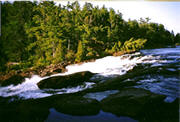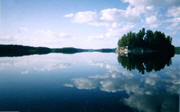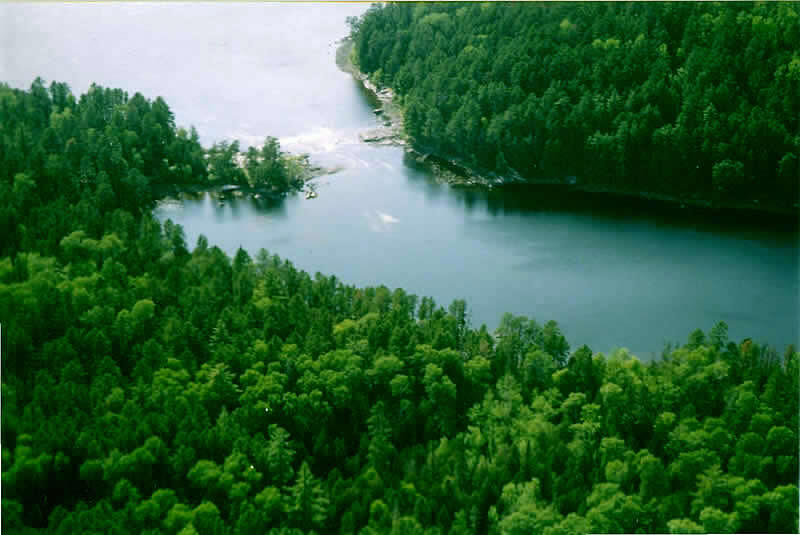 |
“The Canadian voyageur is a man with an
adventurous spirit, ready and willing, capable of being
occasionally, successively, or all at once a discoverer,
interpreter, lumberjack, colonist, hunter, fisher,
sailor, and warrior. He strongly possesses all of these
qualities, even though he does not always have the
opportunity to practice them all.” |
Taken from Forestiers et voyageurs, by
Joseph-Charles Taché, 1863
 Voyageurs were
considered the heroes of the fur trade through the 17th
and 18th century – when the fur trade was the
backbone of the Canadian economy. They were tireless
paddlers with boisterous personalities, an incredible
sense of pride in their work and a fierce dedication to
the task at hand. Paddling canoes 25 – 40 ft in length
they criss-crossed the North American continent carrying
as much as 3,000 lbs of supplies, trade goods and furs
in a load. Voyageurs were
considered the heroes of the fur trade through the 17th
and 18th century – when the fur trade was the
backbone of the Canadian economy. They were tireless
paddlers with boisterous personalities, an incredible
sense of pride in their work and a fierce dedication to
the task at hand. Paddling canoes 25 – 40 ft in length
they criss-crossed the North American continent carrying
as much as 3,000 lbs of supplies, trade goods and furs
in a load.
The vast majority
of Voyageurs were French-Canadians from the hamlets of
the lower St. Lawrence from Montreal to Quebec City.
They averaged 5’ 6” in height and rarely exceeded 5’8”
so as not to take up too much precious cargo space in
the canoe. They all smoked pipes, they all sang (better
singers were actually paid more) and they could all
carry at least 200 lbs at a time over portages. Their
personal possessions were rarely more than they could
carry on their backs. They lived a tireless life
traveling in their canoes and were incredibly proud of
it. Among the ranks of the labourers it was considered
a great gift to grow no taller than 5’6” so as to become
a Voyageur.

In the Rainy Lake Region, west of Grand Portage (home to
this year’s Raid the North Extreme) (where Raid the
North Extreme will take place), the Voyageurs paddled
what was known as the “canot du nord” or “North Canoe”.
Smaller than the canoe used on the Great Lakes, it
typically measured roughly 25 feet in length and 4-6
feet wide. Although it weighed less than 300 lbs it
could carry weights up 3,000 lbs plus crew members
(usually 8). With a good crew the canoes typically moved
at a speed of 6-10 km/hour.
 Patterned on the Ojibway and Algonquin styles, the
North Canoe was made of birch, birchbark, white
cedar, and spruce. No nails or metals of any sort were
used. Starting with the rind of a birch tree, strips of
bark would be sewn together using the fine roots of a
red spruce and then placed over a frame made of thin
white cedar boards. Four to nine thwarts were attached
to the gunwales to maintain the shape of the boat and
then the entire structure was made watertight with
melted sap from a pine tree. The process, known as
“gumming”, would have to be repeated daily to repair and
maintain the canoe. Patterned on the Ojibway and Algonquin styles, the
North Canoe was made of birch, birchbark, white
cedar, and spruce. No nails or metals of any sort were
used. Starting with the rind of a birch tree, strips of
bark would be sewn together using the fine roots of a
red spruce and then placed over a frame made of thin
white cedar boards. Four to nine thwarts were attached
to the gunwales to maintain the shape of the boat and
then the entire structure was made watertight with
melted sap from a pine tree. The process, known as
“gumming”, would have to be repeated daily to repair and
maintain the canoe.
As would be
expected, the canoes were quite fragile. The paddlers
and passengers would sit in one spot at all times to
avoid damage. In fact, passengers were typically
carried to the canoe on the back of a Voyageur and set
in place to avoid bringing the canoe onto shore or
having a clumsy passenger step in the wrong place. If
there was a strong headwind the crew would often pull
ashore since a large wave could badly damage a canoe.

Voyageurs pushed
themselves hard. They would typically paddle 15-18
hours per day covering up to 50 kilometres including
overland portages. Often paddling as fast as 1 stroke
per second they would sing back and forth tirelessly,
breaking every few hours to smoke a pipe.
 When
portaging their large cargo loads they would typically
carry two 100 lb packs at a time. At night they would
quickly cook dinner, repair and re-gum their canoe and
then sleep under it. Although to an outsider this would
sound like a life of endless toil, the Voyageurs took
great pride in their title. When
portaging their large cargo loads they would typically
carry two 100 lb packs at a time. At night they would
quickly cook dinner, repair and re-gum their canoe and
then sleep under it. Although to an outsider this would
sound like a life of endless toil, the Voyageurs took
great pride in their title.
|





